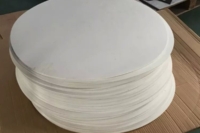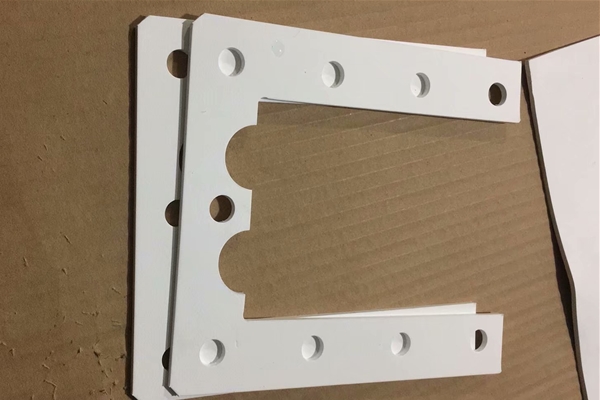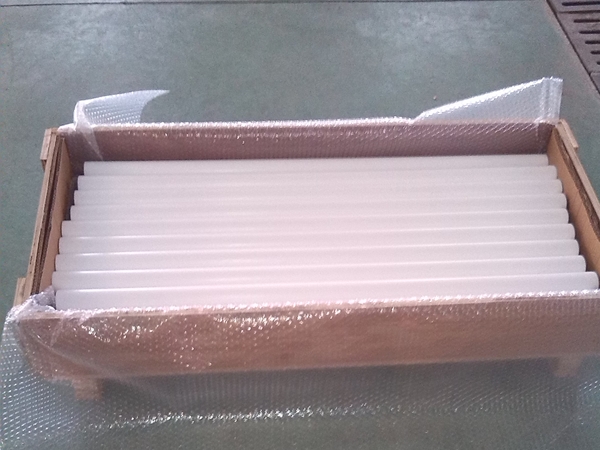1)Expanded PTFE vs. PTFE: What’s the difference?
PTFE
Polytetrafluoroethylene offers near-universal chemical resistance, non-stick and low-friction properties, excellent electrical insulation, and a very wide service temperature range (- -180 to +260 °C ). Vigin PTFE is essentially inert to most chemicals (exceptions include molten alkali metals and highly reactive halogen fluorides such as ClF₃/ClF₅, and liquid chlorine under certain conditions).
Engineering caveat: Virgin PTFE is dense and non-porous with relatively low elastic recovery and is prone to cold flow/creep under sustained load, especially near the upper end of its temperature range.
Expanded PTFE (ePTFE)
Expanded PTFE is produced by stretching PTFE to form a fibrillated, micro-porous network (generally pore scale ~10–100 μm). The result is a soft, highly conformable material with exceptional compressibility and recovery. The micro-fibrils flow into machining marks, scratches, and corrosion pits, creating a self-adapting seal at lower seating stresses than virgin PTFE.
ePTFE retains PTFE’s chemical inertness and wide temperature range, while significantly enhancing sealability, creep resistance, and tolerance to flange imperfections.
2) Material Structure & Sealing Mechanism
ePTFE micro-network: Interconnected fibrils + nodes generate countless micro-pores. Under bolt load, fibrils extend and reorient, actively filling surface defects to close leak paths.
Virgin PTFE: Homogeneous, non-porous, higher Shore D hardness (≈D50–65). Sealing relies mainly on flange flatness and bolt load; it cannot compensate well for >0.08–0.10 mm surface irregularities.
Bendability & formability: ePTFE maintains integrity through 360° bending and conforms easily to non-ideal faces, while virgin PTFE is comparatively stiff.
3) Technical Data Comparison
| Parameter | ePTFE (Expanded) | PTFE | Engineering Impact |
|---|---|---|---|
| Elastic recovery @ ~10 MPa | > 80% | ~30–40% | ePTFE holds gasket stress and returns after cycling |
| Creep/anti-cold-flow | > 90% seating stress retention after ~10,000 pressure cycles | ~60% after ~1,000 cycles | ePTFE sustains tightness in cycling service |
| Pressure capability | Up to 6.4 MPa | common ≤ 2.5 MPa | ePTFE supports broader duties |
| Temperature range | Flexibility to -180 °C; short-term ≈300 °C | Brittle near -100 °C; cold flow ↑ > 260 °C | ePTFE keeps the seal under extremes |
| Flange imperfection tolerance | Compensates for ≤ 0.3 mm misalignment/irregularity | Requires ≤ 0.1 mm | Less machining/rework with ePTFE |
| Thermal cycling leakage | < 0.001 ppm observed in -50↔150 °C cycling (when properly installed) | > 0.1 ppm typical | ePTFE excels in start/stop services |
4) Chemical & Environmental Resistance
Chemicals: Both Virgin PTFE and ePTFE resist strong acids/alkalis and most solvents. ePTFE’s conformability often extends service life 3–5× in dynamic corrosive duties (e.g., pulsating acid/base transfer) by reducing micro-leak paths.
Temperature: Continuous service commonly rated -180 to +260 °C (-292 to +500 °F). Short-term peaks for modified ePTFE can approach ~300 °C (572 °F) depending on grade.
Purity: Low extractables and non-stick surface suit high-purity, food, and pharma environments
5) Where ePTFE Outperforms
High-risk media: strong acids/alkalis (e.g., 98% H₂SO₄), chlorinated media, toxic or regulated emissions (target very low permeability).
Dynamic disturbance: frequent start/stop (> 5×/day), vibration (amplitude > 0.1 mm), and pronounced thermal/pressure cycling.
Severe boundaries: cryogenics (< -50 °C), flange flatness deviation > 0.15 mm, scratches/pitting/rust on sealing faces.
Low bolt load or non-ideal assembly conditions where a forgiving, high-conformability material is essential.
Where virgin PTFE is suitable:
Static, low-pressure services with very smooth flanges (HVAC water, general utility lines).
Cost-sensitive applications where cycling and flange irregularities are minimal.
Food/medical devices at ambient conditions (with appropriate regulatory compliance).
6) Expanded PTFE Gasket vs. Other Gaskets
Metal gaskets (spiral wound, metal jacketed): Outstanding for high temperature/pressure; however, they depend on controlled seating stress and often require better flange condition. ePTFE can replace some SWG duties ≤ ~10 MPa where chemical resistance, low emissions, and forgiving installation are priorities.
Flexible graphite: Excellent high-temperature capability; ePTFE wins on chemical universality, creep resistance, and low-torque sealing on damaged faces.
Rubber: Great flexibility at low temperature and pressure; limited chemical and temperature range compared to ePTFE.
7) Product Types & Typical Uses
Types of expanded PTFE: Expanded PTFE sheets and Expanded PTFE gaskets(die-cut or CNC-cut gaskets); Expanded PTFE joint sealant tape (for large flanges/manways and uneven faces), Expanded PTFE valve stem seal, PTFE Cord, etc.
Applicable industries: Oil & Gas, Petrochemical, Chemical Processing
Power Generation (steam services, heat exchangers); Pharmaceutical & Food
Pulp & Paper, Marine, Water Treatment, and Semicon utilities.
Common flange standards: ASME B16.5/B16.47, EN 1092-1, and JIS (10K/16K). We support metric/inch sizes for Europe, the USA, and JIS for Japan, Korea, with regional documentation for Southeast Asia.
8) Installation Operations (to avoid leaks & creep)
Flange preparation: Remove rust/burrs, blend scratches; target surface finish Ra ≈ 3.2–6.3 μm.
Gasket fit-up: Keep the ID flush—do not intrude into the flow. Avoid overlapped or “wavy” joints.
Bolting & lubrication: Use matched bolt grades and consistent lubrication; tighten in criss-cross, multi-pass steps.
Hot retorque: After heat-up, a controlled re-tightening can significantly limit early relaxation.
Misalignment control: If > 0.1 mm is expected, prefer ePTFE, consider slightly higher seating stress, or limit rings.
Early-life checks: During initial thermal cycles, monitor for weep points and correct promptly.
9) FAQ about ePTFE and PTFE
Q1: Will ePTFE cold flow like Pure PTFE?
ePTFE’s fibrillated structure greatly reduces creep. With correct seating stress and hot retorque, it maintains > 90% gasket stress after extensive cycling (typical results), far outperforming virgin PTFE.
Q2: What about highly reactive media?
Like PTFE, ePTFE is not suitable for certain highly reactive halogen fluorides or molten alkali metals. Provide full media details for confirmation.
Q3: Can ePTFE replace a spiral wound gasket?
In many medium-pressure and chemically aggressive services—yes, especially where you need low leakage at lower bolt loads or where flanges are imperfect. For very high pressure/temperature extremes, SWG or metal designs may still be preferred.
Conclusion
Expanded PTFE leverages a micro-porous network to deliver adaptive sealing, high recovery, and very low leakage across a wide chemical and temperature jacket. It is the universal, high-purity, low-maintenance choice for many ASME/EN/JIS flanges—particularly where flange condition is less than perfect or cycling is unavoidable.
Virgin PTFE remains a cost-effective option for static, low-pressure, smooth-flange duties.
Choosing the right material for your specific process conditions will optimize operational reliability while reducing leakage emissions.





